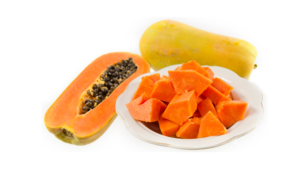Mamão: a fruta tropical cultivada no mundo todo
Carica papaya is the scientific name of papaya, the native fruit of the tropical regions of the Americas, but which is cultivated all over the world. In addition to having an unmistakable aroma and sweet taste, papaya is a source of several vitamins and dietary fibers, bringing benefits to the skin, hair and, mainly, to the intestinal transit.
The opposite of what many believe, the papaya tree is not a tree, but a giant, fast-growing herb, which can reach 10 meters in height. The fruit is found throughout the year and its size, flavor, weight and color can vary according to the species cultivated.

The most popular form of consumption is in natura. Fresh fruit is much appreciated, but it can also be eaten with honey, oatmeal and other seeds. It is also delicious in other preparations, such as smoothies, jellies, sweets and salads. Whether for breakfast, between meals or as dessert, papaya is an excellent food option that satisfies hunger.
In Brazil, the best known varieties are Formosa papaya and Golden papaya. The difference between them starts with their size. The Golden papaya is smaller, no more than 18 centimeters and the weight does not reach 1 kilo. The Formosa, on the other hand, can reach up to 30 centimeters and exceed 3 kilos. Despite the differences, both have similar nutritional properties.
Data from the 2020 Municipal Agricultural Survey (PAM), from the Brazilian Institute of Geography and Statistics (IBGE), reveal that in Brazil, 28.400 hectares are occupied with papaya plantations, totaling 1.2 million tons. National production is concentrated in the extreme south of Bahia, and north of Espírito Santo, in addition to Rio Grande do Norte, Minas Gerais and Ceará.
Brazil also stands out on the international scenario. According to the Brazilian Association of Producers Exporters of Fruits and Derivatives (Abrafrutas), in the first half of 2022, Brazil exported around 22 thousand tons of papaya, with revenue of US$ 26.7 million. The municipality of Linhares, in the north of Espírito Santo, is the largest papaya exporter in the country.
The main destination for Brazilian papaya is the European Union, with emphasis on Portugal, Spain and the Netherlands, which together accounted for 47.7% of the total volume exported in 2021.
The producer of papaya and other fruits, Rodrigo Martins, from Linhares (ES), exported, from January to June this year, 5.6 thousand tons of papaya through the companies Union of Growers of Brazilian Papaya (UGBP) and Doce Fruit. For him, the Brazilian papaya stands out among the others for being produced with food safety, good agricultural practices and sustainability. “Our papaya has the best traceability system and good agricultural practices in the field and in the packing house. Not to mention the flavor and appearance of the fruit, which are highly appreciated on the European continent,” said Rodrigo.
Meet the papaya exporters in Brazil – https://frutasdobrasil.org/pb/exportadores/

